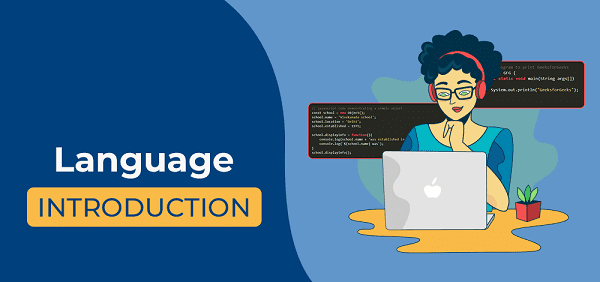Introduction to the language- An “Introduction to the Language” typically refers to a brief overview of a particular programming or natural language, depending on the context. Let’s explore both aspects:
1. Programming Language: A programming language is a formal system used to instruct computers to perform specific tasks. Here’s an introductory outline for a programming language:
- Definition: A programming language is a set of rules and conventions that allows humans to communicate with computers. It consists of a vocabulary (keywords and symbols) and a grammar (rules for combining them).
- Purpose: Programming languages are used to write software, which can range from simple scripts to complex applications. They enable developers to give precise instructions to a computer to perform tasks and solve problems.
- Examples: Some commonly used programming languages include Python, Java, C++, JavaScript, and Ruby, among many others. Each language has its unique features and use cases.
- Syntax: Programming languages have specific syntax rules that dictate how code should be structured. Syntax errors can prevent code from running correctly.
- Paradigms: Programming languages can be categorized into different paradigms, such as imperative, object-oriented, functional, or declarative. These paradigms describe how code is organized and executed.
- IDEs: Integrated Development Environments (IDEs) are software tools that help developers write, test, and debug code in a specific programming language.
- Compilation vs. Interpretation: Some languages are compiled (translated into machine code before execution), while others are interpreted (executed line by line). This distinction affects how code is run.
2. Natural Language: A natural language is a language spoken or written by humans. Here’s an introductory outline for natural language:
- Definition: A natural language is a human language that has evolved over time to facilitate communication. Examples include English, Spanish, Mandarin, and many others.
- Purpose: Natural languages are used for communication among people. They are complex systems of expression, and they are used for a wide range of purposes, including daily conversation, literature, science, and more.
- Grammar: Natural languages have intricate grammatical rules that govern sentence structure, word order, and the use of words and symbols.
- Diversity: There are thousands of natural languages in the world, each with its own unique vocabulary, grammar, and cultural context. Many languages are spoken by a limited number of people.
- Evolution and Change: Natural languages evolve and change over time. New words and expressions are constantly added, and older ones can become obsolete.
- Translation: Translating between natural languages can be challenging due to differences in grammar, idioms, and cultural nuances. Translation tools and techniques help bridge these gaps.
- Literature and Culture: Natural languages are closely tied to the culture and history of the people who speak them. They play a significant role in literature, arts, and identity.
These introductory points provide a basic understanding of both programming and natural languages, which are fundamental tools for communication and problem-solving in the realms of computers and human society, respectively.
What is Introduction to the language
“Introduction to the language” is a broad phrase that can refer to an initial overview or basic information about a particular language, and the specific context in which this phrase is used can vary. It can apply to both programming languages and natural languages. Let’s explore both possibilities:
1. Programming Language: In the context of a programming language, an “introduction to the language” typically includes information about a particular programming language. It covers the language’s syntax, basic features, data types, and key concepts. This introduction is often aimed at programmers who want to start learning a new language. It provides the foundation for understanding and working with the language effectively.
For instance, an “Introduction to Python” might include explanations of Python’s basic syntax, variables, data structures, control flow, and simple code examples to illustrate these concepts.
2. Natural Language: In the context of a natural language, an “introduction to the language” might refer to a basic introduction to a foreign language or a language learning course. This would involve teaching fundamental concepts such as common phrases, grammar rules, and pronunciation to individuals who are new to that language.
For example, an “Introduction to Spanish” course would provide an overview of the Spanish language, including greetings, basic vocabulary, sentence structure, and possibly some cultural context.
The specifics of what’s covered in an “introduction to the language” can vary widely depending on the context and the audience it’s intended for. In both cases, the goal is to provide a foundational understanding of the language, whether it’s a programming language used for computer programming or a natural language used for communication.
Who is Required Introduction to the language
“Required Introduction to the language” can refer to a mandatory or essential introduction to a language, and the specifics of who might need this introduction can vary based on the context. Here are a few possibilities:
- New Learners: For individuals who are beginning to learn a new programming language or a foreign natural language, a “Required Introduction to the language” might be part of their curriculum. This introduction helps them grasp the basics and build a foundation for further learning.
- Software Developers: In the context of programming languages, software developers who are transitioning to a new language may be required to go through an introduction to that language. This is common in organizations where developers are expected to work with multiple programming languages.
- Students: Language courses in educational institutions may require students to take an “Introduction to the language” course, especially if they are pursuing a degree or certification related to that language. This is common in language majors and language education programs.
- Immigrants or Expatriates: In the context of natural languages, immigrants or expatriates moving to a new country may be required to take language courses as part of integration or assimilation programs. This introduction helps them learn the language spoken in their new environment.
- Job Training: In some job roles, especially those involving customer service or international business, employees may be required to undergo language training as part of their job preparation. This ensures they can communicate effectively with customers or partners in other regions.
- Cultural Exchange Programs: Participants in cultural exchange programs or study abroad programs might be required to complete an “Introduction to the language” course to prepare them for their stay in a foreign country.
The need for a “Required Introduction to the language” depends on the specific situation and the goals of the individuals or organizations involved. In many cases, it is a way to ensure that individuals have the necessary language skills to function effectively in a particular context, whether that’s in the world of programming or daily life.
When is Required Introduction to the language

The timing for a “Required Introduction to the language” can vary widely depending on the specific context and purpose. Here are several scenarios when such an introduction might be required:
- Academic Courses: In educational settings, a “Required Introduction to the language” often occurs at the beginning of a semester or academic year. Students taking language courses as part of their curriculum will typically take this course at the start of their language learning journey.
- Language Learning Programs: Language learning programs for individuals who want to acquire proficiency in a foreign language may offer “Introduction to the language” courses at various times. Some programs might start new cohorts on a regular schedule, while others may have rolling enrollment.
- New Employee Onboarding: In a professional context, when a company requires its employees to learn a specific programming language or a foreign language for job-related tasks, the introduction may be part of the onboarding process. This can occur when someone joins a new company or as part of ongoing professional development.
- Immigration or Relocation: Immigrants or expatriates who are required to learn a new language as part of their relocation or immigration process often begin their “Introduction to the language” courses as soon as they arrive in the new country.
- Job-Specific Training: Some job roles, such as customer service representatives, may require language training as part of job-specific training programs. The timing of this training can vary but is often done during the initial phases of employment.
- Cultural Exchange Programs: Participants in cultural exchange or study abroad programs may be required to take an “Introduction to the language” course before or during their stay in a foreign country to help them adapt to the local language and culture.
- Personal Learning: For self-learners, the timing for an introduction to a new language is flexible. It can start whenever the individual decides to begin their language learning journey.
The timing of a “Required Introduction to the language” depends on the specific goals, needs, and constraints of the program, organization, or individual involved. It can happen at the beginning of a formal program, upon entering a new job, or as part of a broader adaptation process.
Where is Required Introduction to the language
The location or setting for a “Required Introduction to the language” can vary depending on the context and purpose of the language learning or training program. Here are some common locations or settings where such introductions can take place:
- Educational Institutions: For students learning a new language as part of their academic curriculum, the “Required Introduction to the language” often takes place in schools, colleges, and universities. These institutions have language departments and classrooms where language courses are conducted.
- Language Learning Centers: Language learning centers or language schools are dedicated facilities that provide language courses. These centers offer introductory language courses, and the “Required Introduction to the language” may be held at these centers.
- Online Learning Platforms: In the digital age, many language learning programs are available online. Students and learners can access introductory language courses through various online platforms, often from the comfort of their homes.
- Corporate Training Centers: In a professional context, when language training is required for employees, it may occur at corporate training centers or on the company’s premises. Some companies bring in language instructors to conduct on-site training.
- Immigration and Relocation Services: For individuals immigrating to a new country or relocating for work, the “Required Introduction to the language” may be provided through immigration or relocation services. Language training centers or services can be located within these organizations or may be outsourced to language schools.
- Community or Cultural Centers: In some cases, language courses, including introductory courses, are offered at community centers or cultural institutions. These centers may provide language instruction for individuals interested in learning about a specific culture and its language.
- Language Training Apps: With the rise of language learning apps and platforms, individuals can access introductory language courses through mobile devices or computers, allowing them to learn from anywhere.
- Cultural Exchange Programs: Participants in cultural exchange or study abroad programs might receive introductory language training at the host institution or as part of their orientation upon arrival in the host country.
- Personal Settings: For self-learners or individuals who wish to learn a language on their own, the “Required Introduction to the language” can take place in the comfort of their own homes or wherever they choose to study.
The specific location can vary based on the program’s format, whether it’s in-person, online, or a combination of both. Additionally, it depends on whether the language learning is associated with formal education, professional development, or personal interest.
How is Required Introduction to the language
The structure and format of a “Required Introduction to the language” can vary widely depending on the specific context, audience, and goals of the language learning program. However, here are some common elements and approaches that may be used in such introductions:
- Curriculum and Course Material: Language introductions often include a structured curriculum that covers the basics of the language. This curriculum typically includes textbooks, online resources, or course materials that provide information on vocabulary, grammar, and pronunciation.
- Language Instructors: In many cases, language introductions are led by experienced language instructors or teachers. These instructors guide students through the learning process, explain concepts, provide examples, and offer support.
- Classroom or Online Sessions: Depending on the format, “Introduction to the language” can be offered in traditional classrooms or through online sessions. Classroom settings are common in educational institutions, while online sessions are popular in distance learning or self-paced courses.
- Interactive Activities: Language introductions often include interactive activities like speaking exercises, role-playing, and group discussions to help students practice their language skills. These activities can be in-person or conducted via video conferencing or online forums.
- Listening and Speaking Practice: Developing listening and speaking skills is a key component of language learning. Language introductions may include listening to native speakers, repeating phrases, and engaging in dialogues.
- Cultural Context: Understanding the cultural context of the language can be important. Language introductions might include lessons on cultural nuances, customs, and etiquette related to the language being taught.
- Assessments: To evaluate progress, language introductions may include assessments, quizzes, or tests to gauge the students’ understanding of the material.
- Language Software and Apps: Language learning software and apps often supplement introductions, providing interactive exercises and self-assessment tools for learners.
- Support and Resources: Language learners are typically provided with support resources, such as language labs, tutoring, online forums, and access to language instructors for questions and clarifications.
- Cultural and Language Immersion: Some programs offer immersion experiences, where students are exposed to the language and culture in real-life situations. This can include language immersion trips or cultural exchange programs.
- Progress Tracking: Many language introductions use progress tracking systems to help students monitor their advancement in the language.
The format and approach can differ significantly depending on the institution or program, whether it’s a formal educational setting, a language school, an online platform, or a self-paced learning initiative. The “Required Introduction to the language” is designed to provide students with the essential knowledge and skills to communicate effectively in the target language and may be tailored to the specific needs and goals of the learners.
Case Study on Introduction to the language
Language Introduction for International Business
Background: ABC Corporation is a global company with offices and clients in various countries. To enhance communication and collaboration among its employees, ABC has decided to provide language training for its staff who frequently engage with international clients. The goal is to introduce the key language and cultural aspects necessary for effective business interactions.
The Challenge: Many of ABC’s employees are proficient in English, which is the company’s primary language of communication. However, they require an “Introduction to the language” program for Mandarin Chinese, as a significant portion of their clients and partners are based in China. The challenge is to provide an effective and tailored introduction to the Mandarin language and Chinese culture for business purposes.
The Solution: ABC Corporation partners with a language training company that specializes in corporate language solutions. Together, they design a program for an “Introduction to Mandarin Chinese” to address the specific needs of ABC’s employees in the context of international business. The program follows these steps:
- Assessment: A pre-training assessment is conducted to gauge the employees’ existing language skills and their specific requirements for business communication.
- Custom Curriculum: Based on the assessment results, a custom curriculum is developed. It focuses on essential business vocabulary, phrases, and cultural nuances relevant to ABC’s industry.
- Instructors: Experienced language instructors with a background in business language training are chosen to lead the program. They are fluent in Mandarin and have knowledge of the business practices in both China and the international arena.
- Classroom and Online Learning: To accommodate employees across various time zones, the program offers both in-person classes at the company’s headquarters and online sessions using video conferencing.
- Interactive Learning: The curriculum includes interactive activities such as mock business negotiations, cross-cultural communication simulations, and language practice with real-world scenarios.
- Cultural Understanding: In addition to language skills, the program includes modules on Chinese culture, etiquette, and business customs to help employees navigate cultural differences effectively.
- Assessments and Feedback: Periodic assessments and feedback sessions are conducted to track progress. Employees receive individualized feedback and guidance for improvement.
- Support Resources: Language learning software and apps are provided to enhance learning outside the classroom. Employees also have access to language tutors and support forums.
Results: The “Introduction to Mandarin Chinese” program has yielded positive outcomes for ABC Corporation:
- Employees are more confident and skilled in communicating with their Chinese clients, leading to improved business relationships.
- Cross-cultural understanding has reduced misunderstandings and miscommunications, fostering a more harmonious working environment.
- The program has increased employee engagement and commitment to international business ventures, benefiting the company’s global expansion.
- ABC Corporation now plans to offer similar language introductions for other regions, further enhancing its global communication capabilities.
This case study demonstrates how an “Introduction to the language” can be tailored to meet the specific needs of a business, enabling employees to communicate effectively and navigate cultural differences in international contexts.
White paper on Introduction to the language
Table of Contents
- Executive Summary
- A brief overview of the white paper’s main findings and recommendations.
- Introduction
- The importance of language learning.
- Objectives of the white paper.
- The Significance of Learning a Language
- The benefits of learning a new language.
- The role of languages in global communication and collaboration.
- Types of Language Learning
- Formal education in schools and universities.
- Language courses and programs.
- Self-directed language learning.
- Language immersion experiences.
- Language Learning Contexts
- Language learning for individuals.
- Language learning in the business world.
- Language learning in academia.
- Language learning for immigrants and expatriates.
- Elements of a Successful Introduction to the Language
- Language goals and objectives.
- Curriculum development.
- Effective teaching methodologies.
- Assessments and progress tracking.
- Cultural understanding.
- Language Learning Resources and Tools
- Traditional classroom materials.
- Online language learning platforms.
- Mobile apps and software.
- Language immersion experiences.
- Support networks and forums.
- Case Studies
- Real-world examples of successful language introductions.
- How different contexts and approaches impact learning outcomes.
- Challenges and Solutions
- Common challenges in language learning.
- Strategies to overcome these challenges.
- Future Trends in Language Learning
- The role of technology in language learning.
- The growing importance of cross-cultural communication.
- The impact of globalization on language education.
- Recommendations
- Tips for effective language learning.
- Suggestions for educators, institutions, and organizations.
- Strategies for promoting multilingualism and cultural understanding.
- Conclusion
- Summarizing key takeaways from the white paper.
- References
- Citing sources and references used in the white paper.
- Appendices
- Additional resources, such as sample curricula, language learning tools, and case study details.
Executive Summary
Language is a fundamental tool for communication, culture, and personal and professional development. This white paper explores the importance of language learning, discusses various types of language learning, and highlights the elements that contribute to a successful introduction to a language. It also provides insights into language learning resources and tools, case studies of successful language introductions, and offers recommendations for individuals, educators, institutions, and organizations.
In an increasingly interconnected world, language learning plays a crucial role in fostering cross-cultural understanding and global collaboration. As technology and globalization continue to reshape our lives, the ability to learn and adapt to new languages and cultures is becoming an essential skill. This white paper aims to provide guidance and support for those interested in embarking on the journey of language learning and for institutions seeking to provide effective language introductions.
The white paper can be developed further by expanding on each section with relevant research, case studies, and practical insights, providing a comprehensive resource for individuals, educators, and organizations interested in language learning and teaching.





